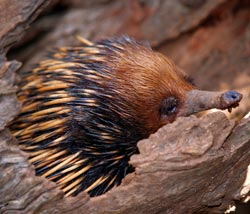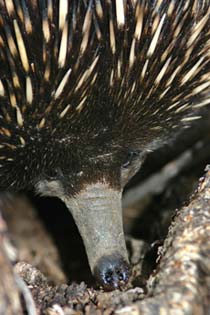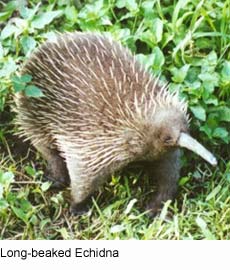|

 Big Nose/Mouth: Echidnas are small mammals that are covered with coarse hair and spines. Big Nose/Mouth: Echidnas are small mammals that are covered with coarse hair and spines.
Superficially they resemble both the anteaters of South America and other spiny mammals like hedgehogs and porcupines. They have snouts which have the functions of both the mouth and nose. Their snouts are elongated and slender. They have very short, strong limbs with large claws and are powerful diggers.
What's For Dinner? Echidnas have a tiny mouth and a toothless jaw. They feed by tearing open soft logs, anthills and the like, and using their long, sticky tongue which protrudes from their snout to collect their prey. The Short-beaked echidna's diet consists largely of ants and termites, while the Zaglossus species typically eat worms and insect larvae.

Short-beak: The Short-beaked echidna (Tachyglossus aculeatus), also known as the Spiny anteater because of its diet of ants and termites, is one of four living species of echidna and the only member of the genus Tachyglossus. The Short-beaked echidna is covered in fur and spines and has a distinctive snout and a specialized tongue, which it uses to catch its prey at a great speed. Like the other extant monotremes, the Short-beaked echidna lays eggs; the monotremes are the only group of mammals to do so.
Echidna in Trouble: The species is found throughout Australia, where it is the most widespread native mammal, and in coastal and highland regions of southwestern New Guinea, where it is known as the Mungwe in the Daribi and Chimbu languages. It is not threatened with extinction, but human activities, such as hunting, habitat destruction, and the introduction of foreign predatory species and parasites, have reduced the distribution of the Short-beaked echidna in Australia.
Vagabonds of the Outback: No systematic study of the ecology of the Short-beak echidna has been published; however, there have been studies of several aspects of their ecological behavior. Short-beaked echidnas live alone and apart from the burrow created for rearing young; they have no fixed shelter or nest site. They do not have a home territory, but range over a wide area.
 Morning People... sort of: Short-beaked echidnas are typically active in the daytime; however, they are ill-equipped to deal with heat, because they have no sweat glands and do not pant. Therefore, in warm weather they change their pattern of activity, becoming crepuscular or nocturnal. They can tolerate cold temperatures, and hibernate during the winter in very cold regions. Morning People... sort of: Short-beaked echidnas are typically active in the daytime; however, they are ill-equipped to deal with heat, because they have no sweat glands and do not pant. Therefore, in warm weather they change their pattern of activity, becoming crepuscular or nocturnal. They can tolerate cold temperatures, and hibernate during the winter in very cold regions.
They Follow the Food! Short-beaked echidnas can live anywhere that has a good supply of food. Short-beaked echidnas locate food by smell, using sensors in the tip of their snout, and regularly feast on ants and termites. They are powerful diggers, using their clawed front paws to dig out prey and create burrows for shelter. They may rapidly dig themselves into the ground if they cannot find cover when in danger.
Where the Echidnas Roam: In Australia they are most common in forested areas where there are abundant termite-filled fallen logs. In agricultural areas, they are most likely to be found in uncleared scrub; they may be found in grassland, arid areas, and in the outer suburbs of the capital cities. Little is known about their distribution in New Guinea, they have been found in southern New Guinea between Merauke in the west, to the Kelp Welsh River, east of Port Moresby in the east, where they may be found in open woodland.

Egg-layers! Apart from the Platypus, the four species of echidna are the only egg-laying mammals. The female lays a single soft-shelled, leathery egg twenty-two days after mating and deposits it directly into her pouch. Hatching takes ten days; the young echidna, called a puggle, then sucks milk from the pores of the two milk patches (monotremes have no nipples) and remains in the pouch for forty-five to fifty-five days, at which time it starts to develop spines. The mother digs a nursery burrow and deposits the puggle, returning every five days to suckle it until it is weaned at seven months.
The Smell of Romance: The solitary Short-beaked echidna looks for a mate between May and September; the precise timing of the mating season varies with geographic location. Both males and females give off a strong odor during the mating season.
 During courtship, males locate and pursue females. Trains of up to ten males may follow a single female in a courtship ritual that may last for up to four weeks; the duration of the courtship period varies with location. During courtship, males locate and pursue females. Trains of up to ten males may follow a single female in a courtship ritual that may last for up to four weeks; the duration of the courtship period varies with location.
In cooler parts of their range, such as Tasmania, females may mate within a few hours of arousal from hibernation. Before mating, the male smells the female, paying particular attention to the cloaca. The male is often observed to roll the female onto her side and then assumes a similar position so that the two animals are abdomen to abdomen.
#1 Egg: Each mating results in the production of a single egg, and females are known to mate only once during the breeding season; each mating is successful. Fertilization occurs in the oviduct. Gestation takes between 21 and 28 days, during which time the female constructs a nursery burrow. Following the gestation period, a single rubbery-skinned egg between 13 and 17 millimeter in diameter is laid directly into a small, backward-facing pouch that has developed on her abdomen. Ten days after it is laid, the egg hatches within the pouch. The embryo develops an "egg tooth" during incubation, which it uses to tear open the egg; the tooth disappears soon after hatching. Hatchlings are about 1.5 cm long and weigh between 0.3 and 0.4 grams. After hatching, young echidnas are known as puggles.
Mother's Milk: Hatchlings attach themselves to their mothers' milk areolae, a specialized patch on the skin that secretes milk (monotremes lack nipples). The way in which puggles imbibe the milk is not yet known, but they have been observed ingesting large amounts during each feeding period, since mothers may leave them unattended in the burrow for between five and ten days. The principal components of the milk are fucosyllactose and saialyllactose; it is high in iron content, giving it a pink color.
Ejected from the Pouch: Juveniles are eventually ejected from the pouch at around two to three months of age, because of the continuing growth in the length of their spines. Suckling gradually decreases until juveniles are weaned at about six months of age. The duration of lactation is about 200 days, and the young leave the burrow between 180 and 240 days. The age of sexual maturity is uncertain, but may be four to five years. A twelve-year field study, published in 2003, found that the Short-beaked Echidna reached sexual maturity between five and 12 years of age, and that the frequency of reproduction varies from once every two years to once every six years. The Short-beaked Echidna can live as long as 45 years in the wild.

Echidnas are classified into two genera. The Zaglossus genus includes three surviving species and two extinct species known only from fossils; while only one species of the Tachyglossus genus is known.
The three living Zaglossus species are endemic to New Guinea. They are rare, and hunted for food. They forage in leaf litter on the forest floor, eating earthworms and insects.
* The Western Long-beaked Echidna (Zaglossus bruijni) of the highland forests.
* Sir David's Long-beaked Echidna (Zaglossus attenboroughi), recently discovered, and prefers a still higher habitat.
* The Eastern Long-beaked Echidna (Zaglossus bartoni), of which 4 distinct subspecies have been identified
The Tachyglossus genus consists only of the Short-beaked Echidna (Tachyglossus aculeatus) is found in south east New Guinea and also occurs in almost all Australian environments: from the snow-clad Australian Alps to the deep deserts of the Outback: essentially anywhere that ants and termites are available. Its size is smaller than the Zaglossus species and it has longer hair.
All text is available under the terms
of the GNU Free Documentation License
|